Table of Contents
- Introduction
- Editor’s Choice
- Clinical Perinatal Software Market Overview Statistics
- Factors Fuelling the Demand for Clinical Perinatal Software Statistics
- Causes of Infant Death Detected Through Clinical Perinatal Software
- Key Components in Clinical Perinatal Software Statistics
- Key Indicators in Clinical Perinatal Software
- Investments in Clinical Perinatal Software
- Regulations for Clinical Perinatal Software
- Recent Developments
- Conclusion
- FAQs
Introduction
Clinical Perinatal Software Statistics: Clinical perinatal software is pivotal in modern obstetric practice. Providing healthcare professionals with a comprehensive suite of tools to manage maternal and fetal health data throughout pregnancy, childbirth, and the postpartum period.
This software integrates electronic health record systems tailored to perinatal care. Enabling real-time monitoring of vital signs, fetal heart rate, and uterine contractions.
Decision support tools aid in informed clinical decision-making, while customizable workflows streamline documentation processes.
Interoperability ensures seamless information exchange with external systems, and telehealth capabilities facilitate virtual prenatal visits and consultations.
Compliance features uphold regulatory standards, safeguarding patient confidentiality. Altogether, clinical perinatal software enhances efficiency, communication, and patient outcomes in obstetric care settings.
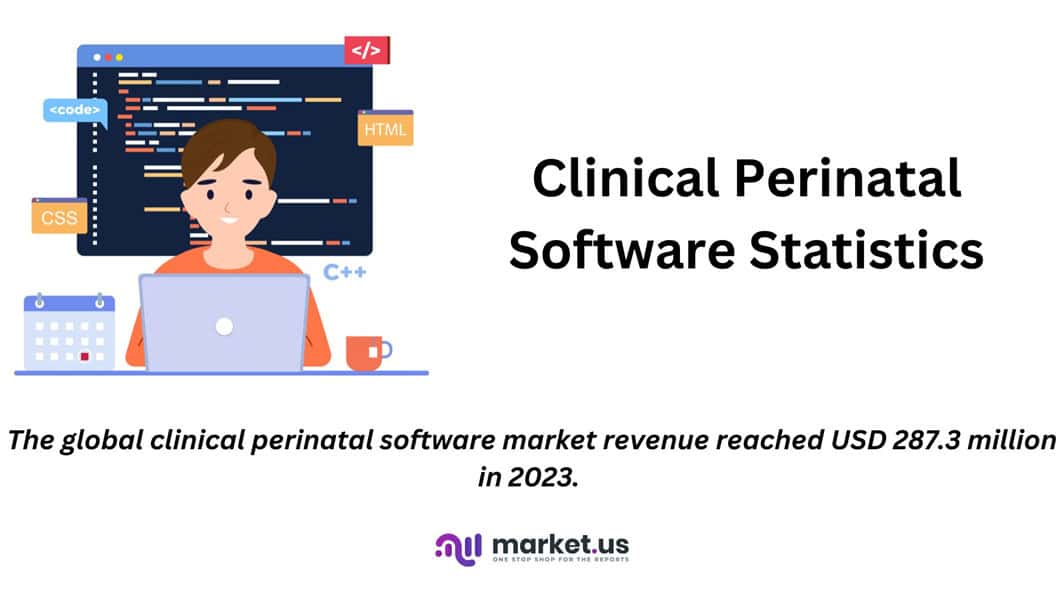
Editor’s Choice
- The global clinical perinatal software market revenue reached USD 287.3 million in 2023.
- In 2033, the market is predicted to achieve USD 808.4 million. With on-premise solutions contributing USD 586.1 million and cloud-based solutions USD 222.3 million.
- The Global Clinical Perinatal Software Market is predominantly driven by integrated solutions. Which holds a substantial market share of 84.70%.
- In the Global Clinical Perinatal Software Market, hospitals and clinics dominate the end-use segment, accounting for 63.80% of the market share.
- Significant contributions from several key players characterize the Global Clinical Perinatal Software Market. Leading the market is PeriGen Inc., which holds a 15% share.
- In 2022, the leading causes of infant death in the United States were diverse. With congenital malformations accounting for 19.30% of all infant deaths.
- In the United States, the Centers for Medicare & Medicaid Services (CMS) has implemented electronic clinical quality measures (eCQMs) such as ePC-02 and ePC-07. Which focus on cesarean birth rates and severe obstetric complications, respectively.
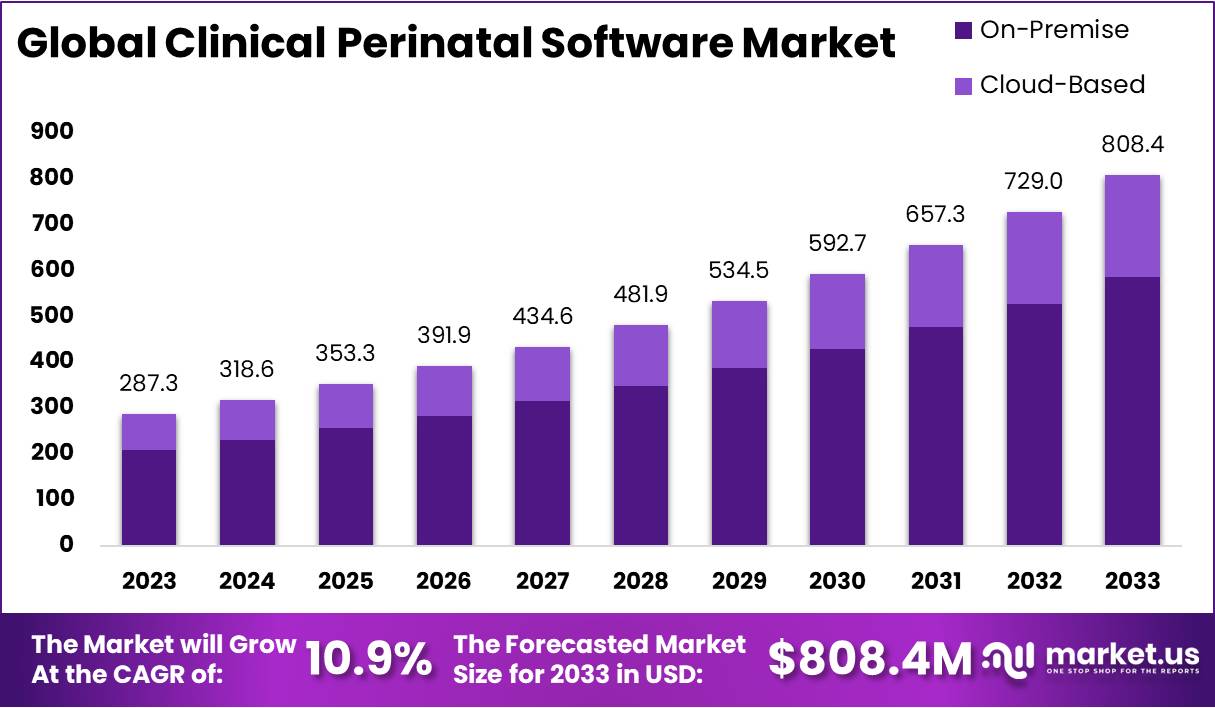
Clinical Perinatal Software Market Overview Statistics
Global Clinical Perinatal Software Market Size Statistics
- The Global Clinical Perinatal Software Market has exhibited a steady growth trajectory at a CAGR of 10.9%. With revenue increasing from USD 287.3 million in 2023 to a projected USD 808.4 million by 2033.
- In 2024, the market is expected to reach USD 318.6 million. Followed by a further increase to USD 353.3 million in 2025.
- This upward trend continues with anticipated revenues of USD 391.9 million in 2026 and USD 434.6 million in 2027.
- By 2028, the market is forecasted to achieve USD 481.9 million, and by 2029, it is projected to reach USD 534.5 million.
- The growth momentum is expected to persist, with market revenues reaching USD 592.7 million in 2030, USD 657.3 million in 2031, USD 729.0 million in 2032, and finally culminating at USD 808.4 million in 2033.
- This consistent growth underscores the increasing adoption and reliance on clinical perinatal software across the healthcare sector.
(Source: market.us)
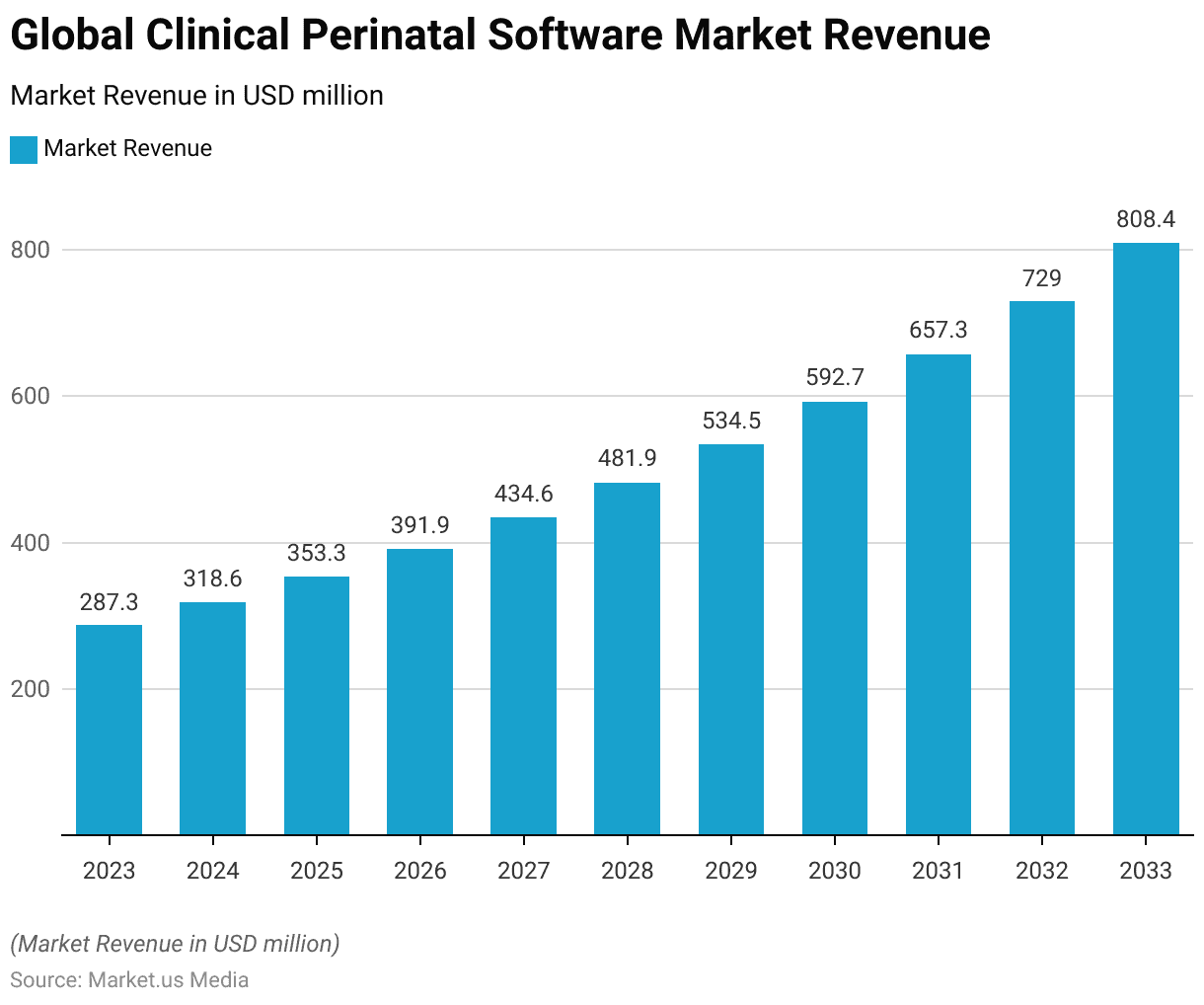
Clinical Perinatal Software Market Size – By Deployment Mode Statistics
- The Global Clinical Perinatal Software Market is projected to grow significantly from 2023 to 2033. Segmented by deployment mode into on-premise and cloud-based solutions.
- In 2023, the total market revenue is expected to be USD 287.3 million. With on-premise solutions contributing USD 208.3 million and cloud-based solutions adding USD 79.0 million.
- By 2024, the market is anticipated to reach USD 318.6 million. With on-premise revenue at USD 231.0 million and cloud-based revenue at USD 87.6 million.
- The market is set to continue its growth trend, reaching USD 353.3 million in 2025. With on-premise and cloud-based revenues at USD 256.1 million and USD 97.2 million, respectively.
- In 2026, the total revenue is forecasted to be USD 391.9 million. With on-premise at USD 284.1 million and cloud-based at USD 107.8 million.
- By 2027, the market is expected to grow to USD 434.6 million. With on-premise and cloud-based revenues of USD 315.1 million and USD 119.5 million.
- The anticipated growth trajectory suggests a steady rise, with projected figures as follows: USD 481.9 million by 2028. With on-premise solutions contributing USD 349.4 million and cloud-based solutions USD 132.5 million.
More Insights
- By 2029, the figures are forecasted to reach USD 534.5 million. Comprising on-premise at USD 387.5 million and cloud-based at USD 147.0 million.
- In 2030, the market is expected to escalate to USD 592.7 million. With on-premise solutions at USD 429.7 million and cloud-based solutions at USD 163.0 million.
- By 2031, it’s projected to reach USD 657.3 million, divided between on-premise (USD 476.5 million) and cloud-based (USD 180.8 million).
- In 2032, the market value is estimated at USD 729.0 million. With on-premise solutions at USD 528.5 million and cloud-based solutions at USD 200.5 million.
- Finally, in 2033, the market is predicted to achieve USD 808.4 million. With on-premise solutions contributing USD 586.1 million and cloud-based solutions USD 222.3 million.
- This data highlights a robust growth trajectory for both deployment modes in the clinical perinatal software market.
(Source: market.us)

Global Clinical Perinatal Software Market Share – By Product Type Statistics
- The Global Clinical Perinatal Software Market is predominantly driven by integrated solutions. Which holds a substantial market share of 84.70%.
- In comparison, standalone products account for a smaller share of 15.30%.
- This significant preference for integrated systems underscores the industry’s inclination towards comprehensive. All-in-one solutions that streamline various perinatal clinical functions, enhancing efficiency and patient care outcomes.
- Standalone products, while still relevant, are less favored, indicating a market trend towards more cohesive and interoperable software solutions in the clinical perinatal sector.
(Source: market.us)

Clinical Perinatal Software Market Share – By End-Use Statistics
- In the Global Clinical Perinatal Software Market, hospitals and clinics dominate the end-use segment, accounting for 63.80% of the market share.
- This significant share is attributed to the high volume of patient visits and the comprehensive adoption of advanced perinatal software solutions in these settings. These facilities benefit from enhanced workflow management and data integration capabilities, which improve patient care and operational efficiency.
- Maternity clinics hold the remaining 36.20% of the market share. These specialized clinics are increasingly adopting perinatal software to enhance maternal and fetal monitoring, streamline administrative tasks, and provide personalized care.
- The growing number of maternity clinics, especially in developing regions, is expected to contribute to their increasing market share.
(Source: market.us)
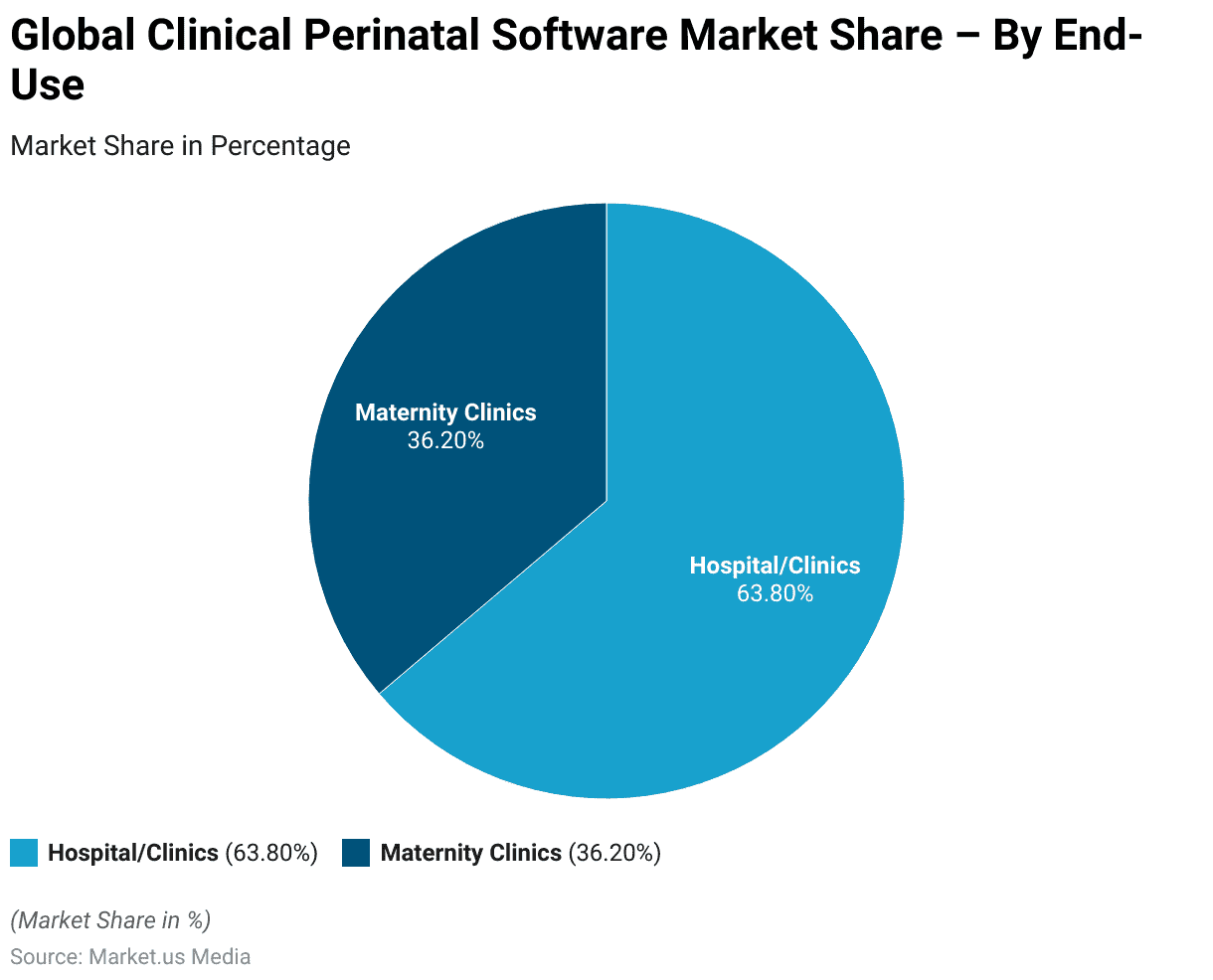
Competitive Landscape of Global Clinical Perinatal Software Market Statistics
- Significant contributions from several key players characterize the Global Clinical Perinatal Software Market.
- Leading the market is PeriGen Inc., which holds a 15% share. Followed closely by Edan Instruments Inc. with 14% and CooperSurgical Inc. with 13%.
- Koninklijke Philips NV captures an 11% market share. While Cognitive Medical Systems and AS Software Inc. each command a 9% share.
- GE Healthcare holds an 8% share, and Bionet contributes 7% to the market.
- The remaining 14% is occupied by various other key players, collectively making up a substantial portion of the market.
- This distribution underscores the competitive landscape and the diverse array of companies influencing the clinical perinatal software sector.
(Source: market.us)
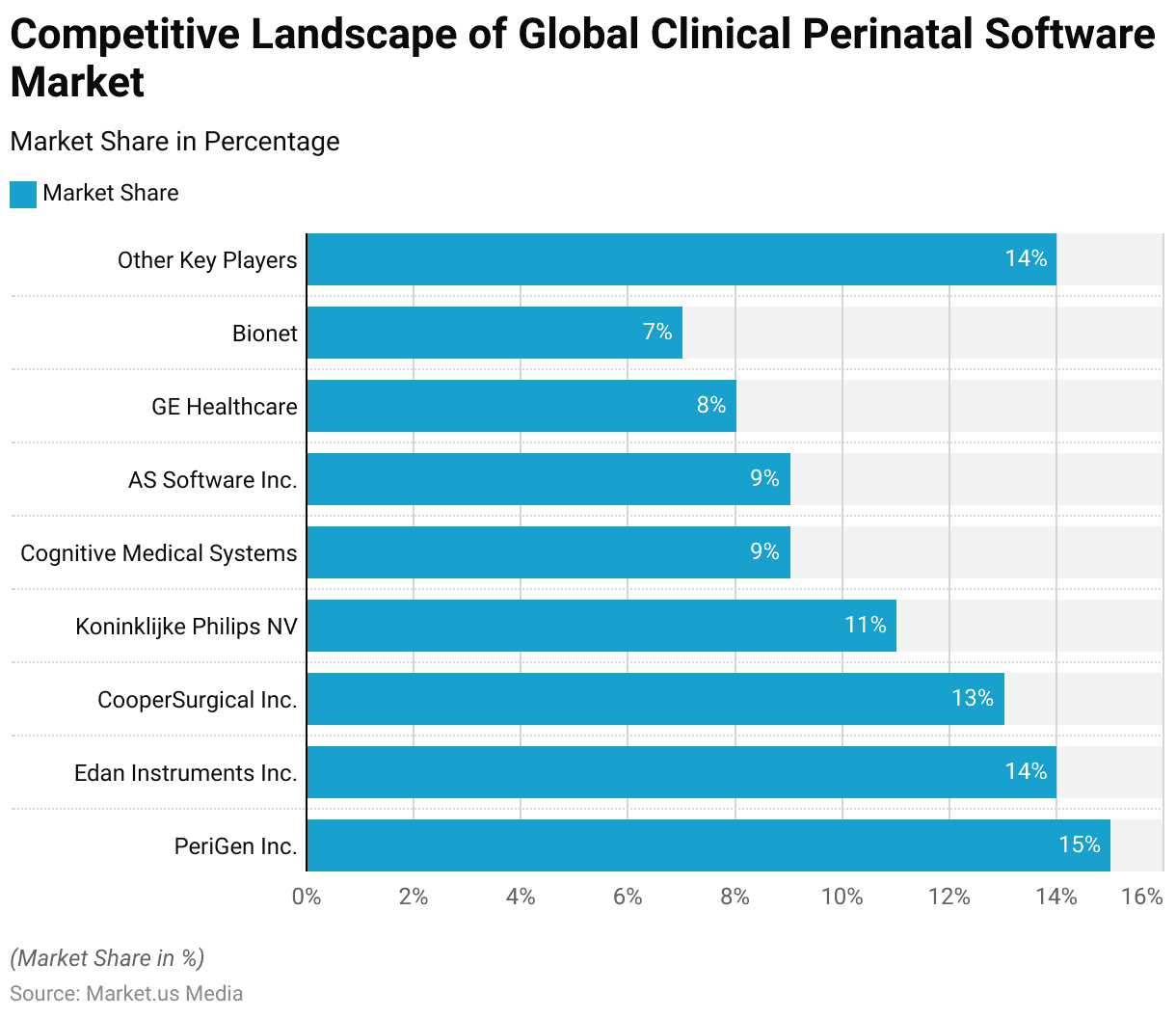
Regional Analysis of the Global Clinical Perinatal Software Market Statistics
- The Global Clinical Perinatal Software Market is characterized by a significant regional distribution. North America leading the market with a substantial 52.0% share.
- Europe follows with a 20.0% share, indicating strong adoption across these regions.
- The Asia-Pacific (APAC) region holds a 15.0% share, reflecting its growing healthcare infrastructure and technological advancements.
- South America accounts for 8.0% of the market, while the Middle East and Africa (MEA) region represents 5.0%.
- This geographical spread highlights the widespread adoption and importance of clinical perinatal software across different regions globally.
(Source: market.us)
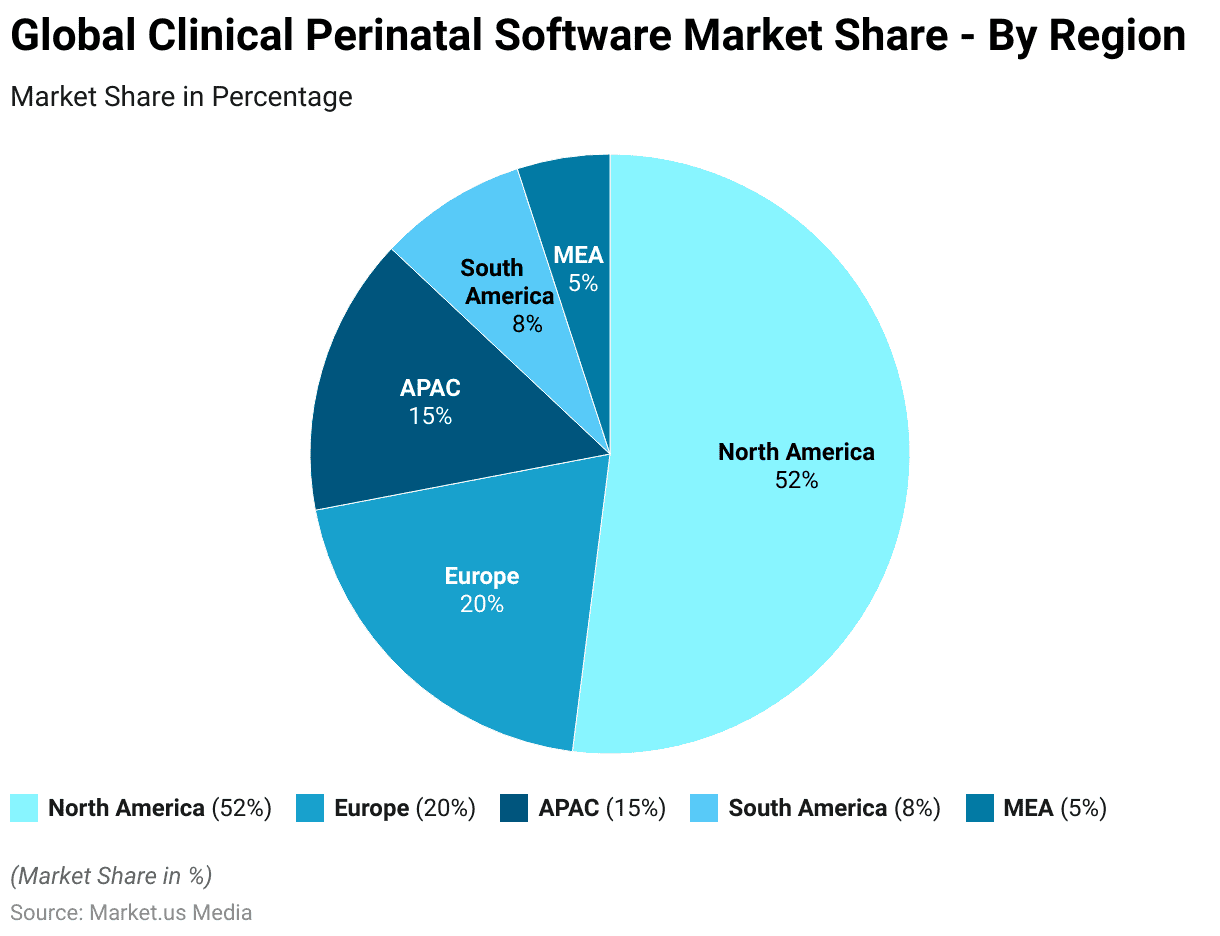
Factors Fuelling the Demand for Clinical Perinatal Software Statistics
Rising Maternal Mortality Statistics
- The countries with the highest maternal mortality rates highlight significant challenges in maternal healthcare.
- South Sudan has the highest rate, with 1,223 maternal deaths per 100,000 live births, followed by Chad at 1,063 and Nigeria at 1,047.
- The Central African Republic also reports a high rate of 835, with Guinea-Bissau at 725 and Liberia at 652.
- Somalia faces a rate of 621, while Afghanistan’s rate is 620.
- Other countries with alarmingly high rates include Lesotho at 566, Guinea at 553, the Democratic Republic of the Congo at 547, Kenya at 530, Benin at 523, and Burundi at 494.
- These figures underscore the urgent need for improved maternal healthcare services and interventions in these regions.
(Source: UNICEF)
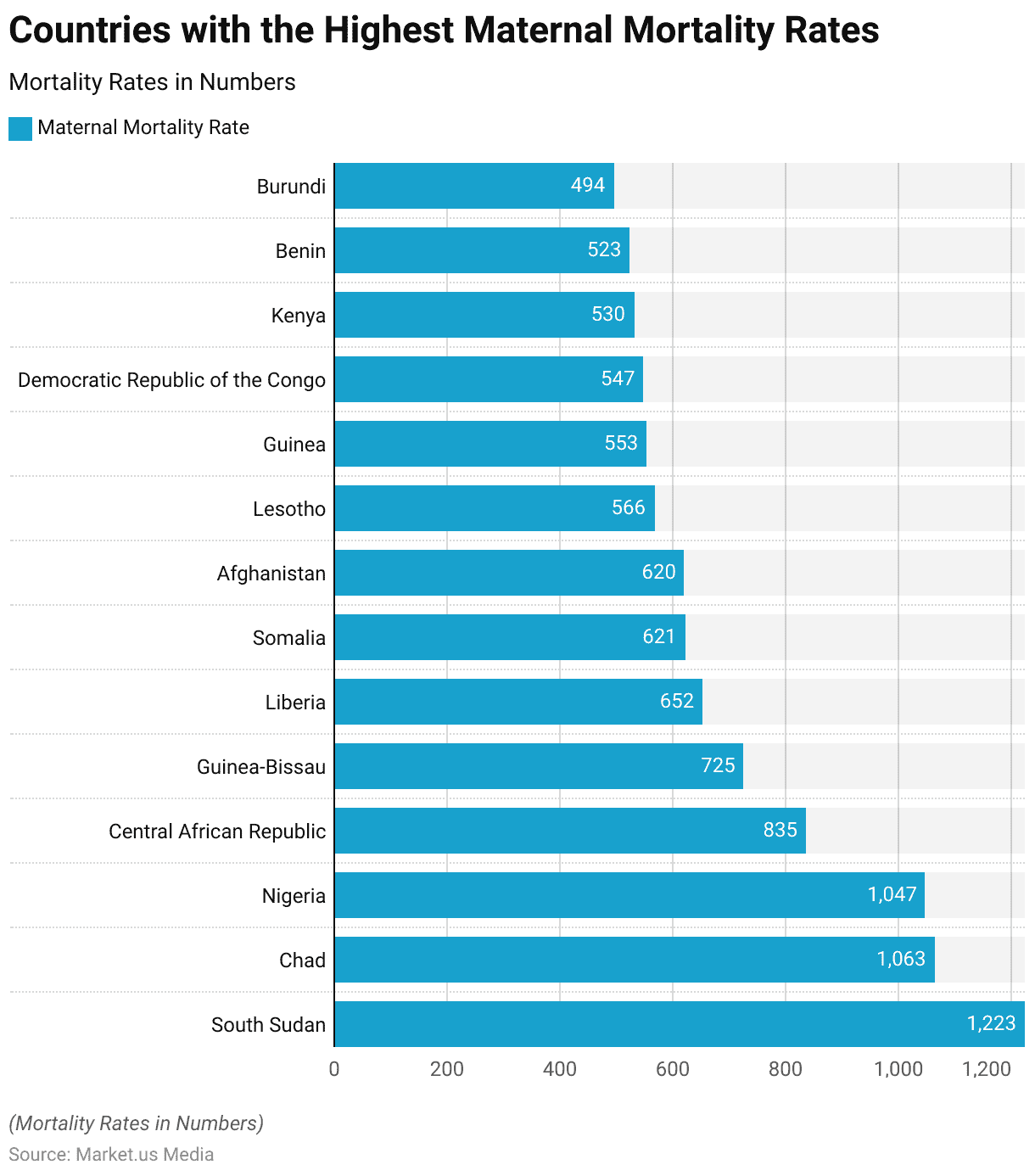
Maternal Mortality Rates – By Race/Ethnicity
- From 2018 to 2022, maternal mortality rates in the United States showed significant variations across different races and ethnicities.
- The overall maternal mortality rate increased from 17.4 per 100,000 live births in 2018 to 32.9 in 2021 before decreasing to 22.3 in 2022.
- Among non-Hispanic White women, the rate rose from 14.9 in 2018 to 26.6 in 2021, then decreased to 19 in 2022.
- Non-Hispanic Black women experienced the highest rates. With a significant increase from 37.3 in 2018 to 69.9 in 2021, followed by a reduction to 49.5 in 2022.
- Hispanic women saw an increase from 11.8 in 2018 to 28 in 2021 before the rate fell to 16.9 in 2022.
- Non-Hispanic Asian women had relatively lower rates. With a slight increase from 13.3 in 2018 to 16.8 in 2021 and a slight decrease to 13.2 in 2022.
- These disparities underscore the persistent racial and ethnic inequalities in maternal health outcomes in the United States.
(Source: Statista)
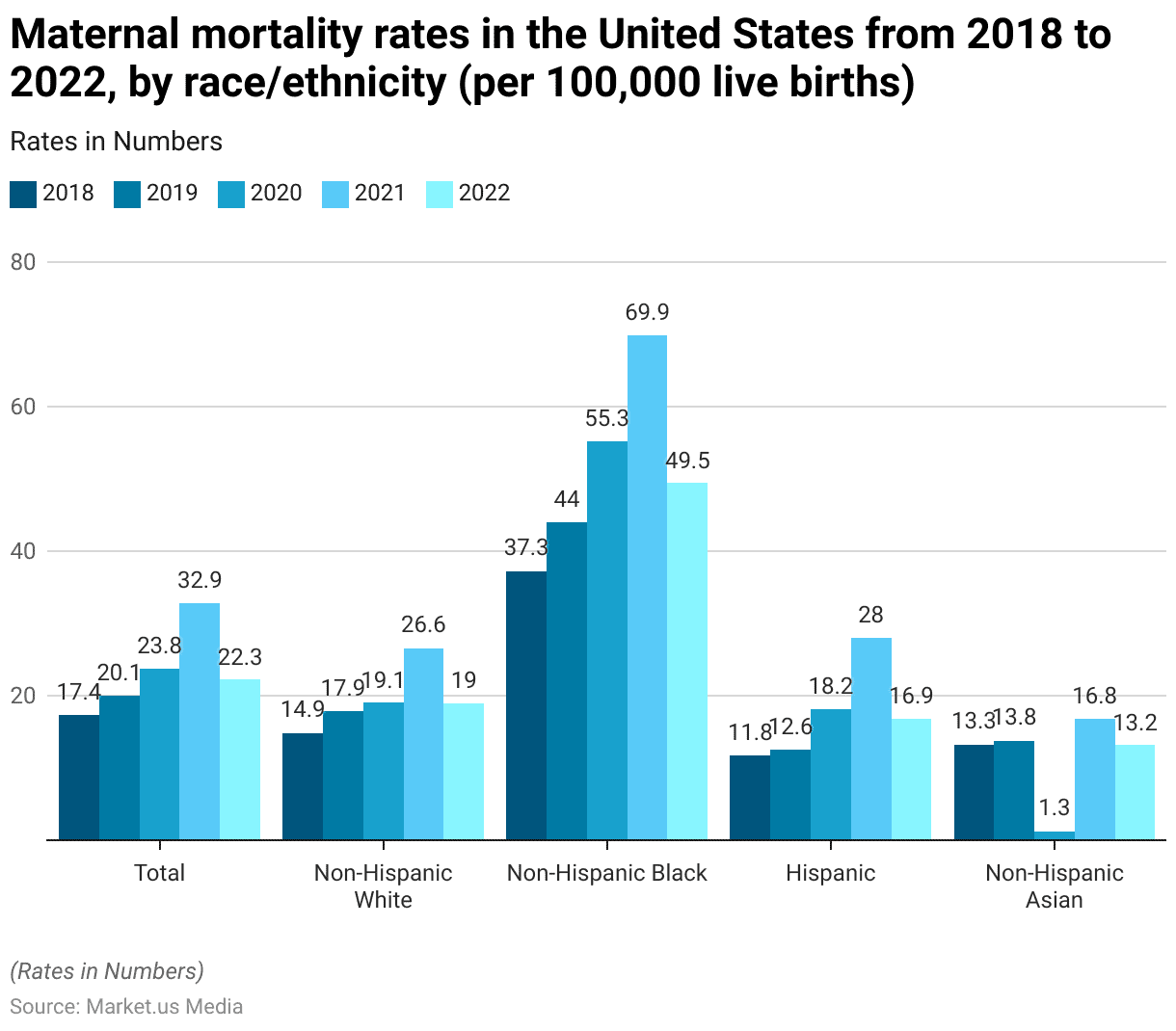
Rising Infant Mortality Statistics
- In 2023, Afghanistan reported the highest infant mortality rate, with 103.06 child deaths per thousand live births.
- Somalia followed with a rate of 85.06, and the Central African Republic recorded 81.74.
- Equatorial Guinea had an infant mortality rate of 77.85, while Sierra Leone reported 72.3.
- Niger and Chad had rates of 65.53 and 63.99, respectively.
- South Sudan recorded 61.63, and Mozambique had a rate of 59.77.
- The Democratic Republic of Congo followed closely with 59.12, and Mali reported 58.99.
- Angola’s infant mortality rate stood at 57.2, with Comoros at 56.01.
- Nigeria and Benin recorded rates of 55.17 and 54.33, respectively, while Côte d’Ivoire had 54.04.
- Pakistan’s rate was 52.73, followed by Mauritania at 49.95.
- Guinea reported an infant mortality rate of 48.32, and Burkina Faso’s rate was 48.17.
- These figures underscore the critical need for enhanced healthcare interventions in these countries to reduce infant mortality rates.
(Source: Statista)
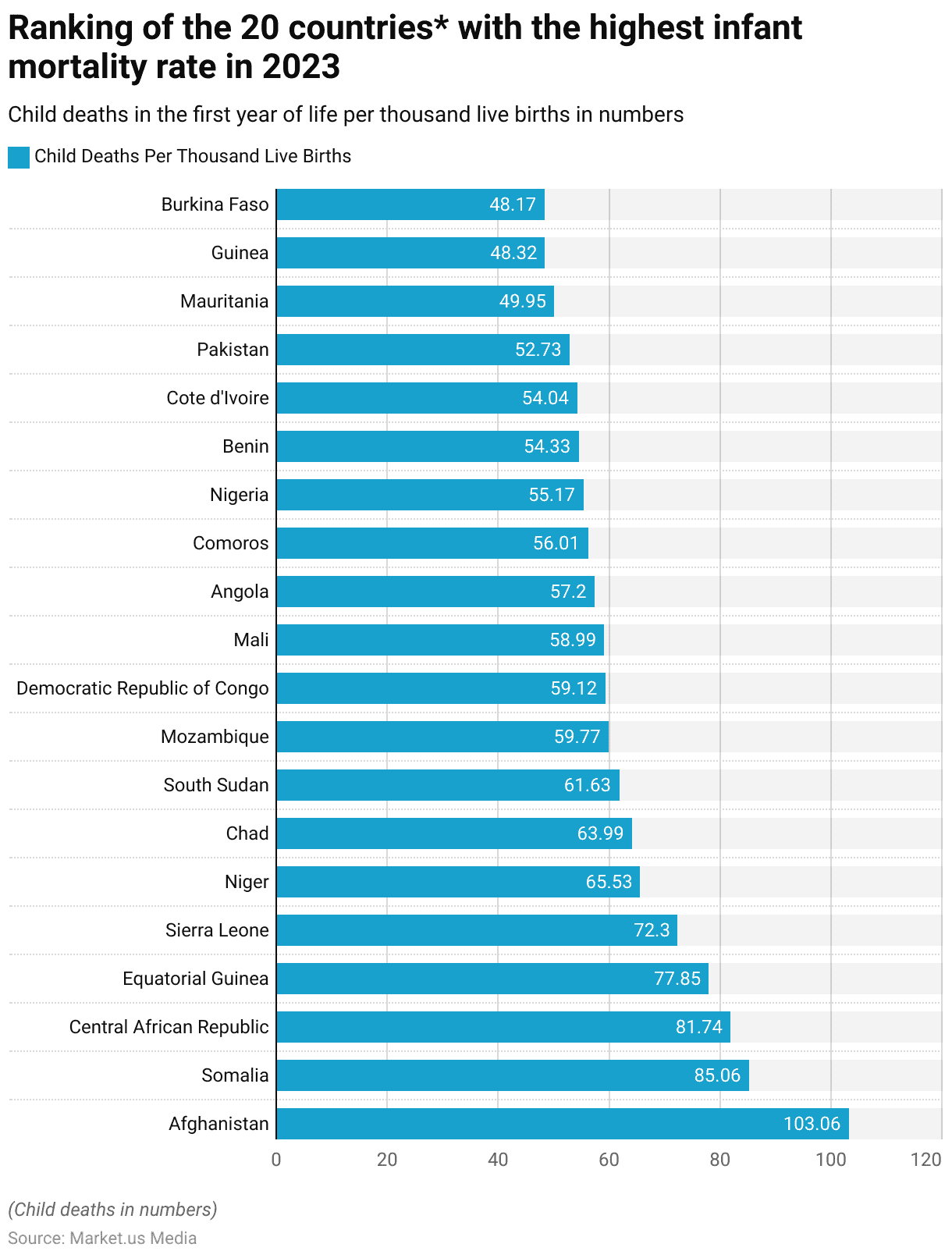
Rising Neonatal Mortality Statistics
- In 2022, Sub-Saharan Africa had the highest neonatal mortality rate, with 27 deaths per 1,000 live births.
- Southern Asia followed with a rate of 22, while Northern Africa recorded 15.
- South-Eastern Asia had a neonatal mortality rate of 12, and both Western Asia and Oceania reported rates of 10.
- Central Asia, Latin America, and the Caribbean each had a rate of 9.
- Eastern Asia and Northern America both recorded rates of 3. While Australia and New Zealand, along with Europe, had the lowest rates of 2.
- These figures illustrate significant regional disparities in neonatal mortality rates. Sub-Saharan Africa has the highest rates and Europe, Australia, and New Zealand have the lowest.
(Source: Statista)
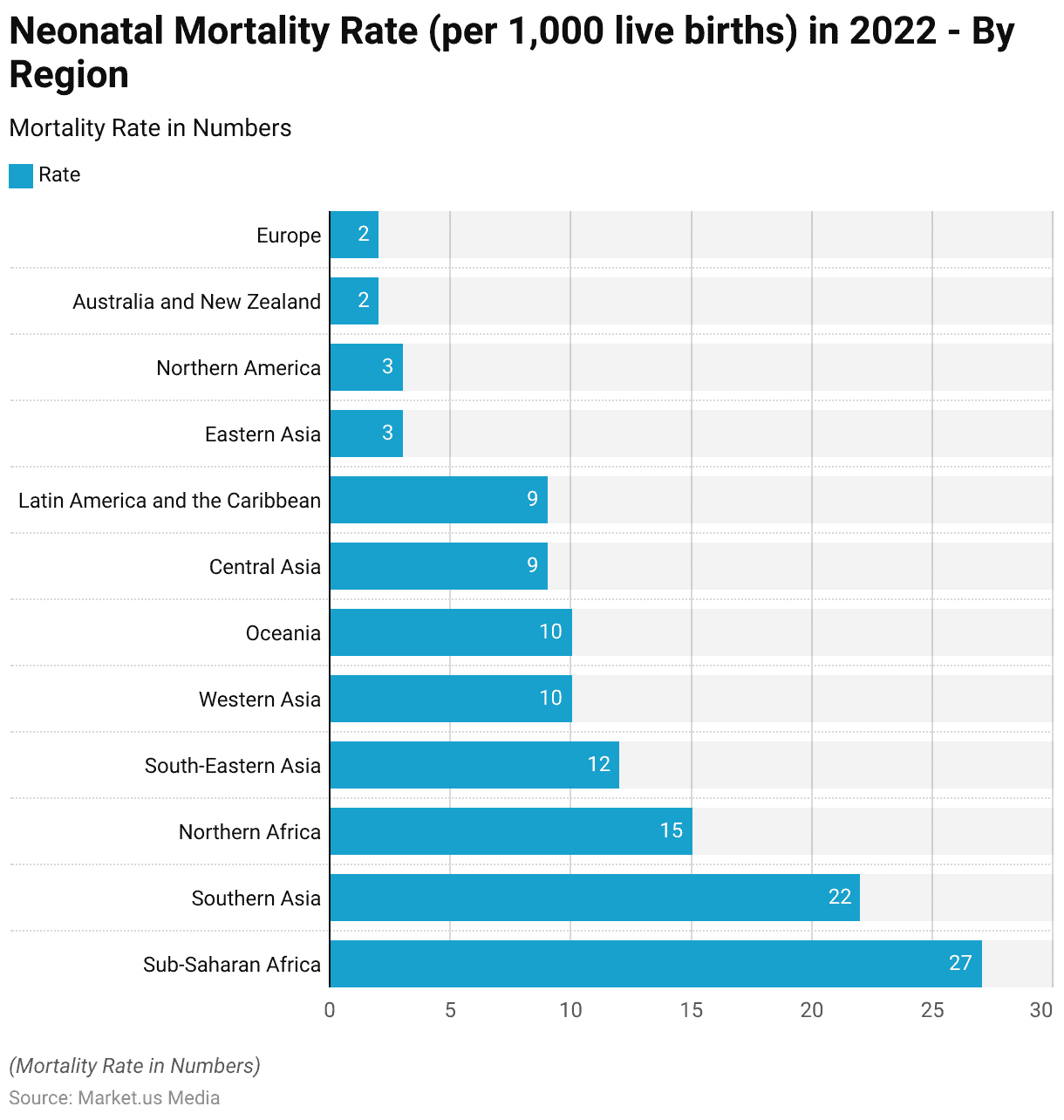
Infant Mortality Rates- By Maternal Pre-Pregnancy BMI and Age
- The rate of infant mortality in the United States from 2017 to 2018 varied significantly by maternal pre-pregnancy body mass and age.
- Among mothers under 20, the infant mortality rates were highest for those who were obese (10.24 per 1,000 live births), followed by underweight (8.46), overweight (7.97), and normal weight (7.82).
- For the 20-24 age group, obese mothers had a rate of 7.72, while underweight, overweight, and normal-weight mothers had rates of 7.06, 6.22, and 6.09, respectively.
- In the 25-29 age group, obese mothers again had the highest rate at 6.8, followed by underweight (5.64), overweight (4.87), and normal weight (4.46).
- For mothers aged 30-34, the infant mortality rate for obese mothers was 6.32, with rates of 4.35 for overweight, 4.24 for underweight, and 3.44 for normal weight.
- In the 35-39 age group, the highest rate was among obese mothers (7.01), followed by overweight (4.79), normal weight (3.66), and underweight (3.81).
- For mothers aged 40 and over, the infant mortality rates were 8.61 for obese, 6.71 for overweight, and 5.26 for normal weight, with no data reported for underweight mothers.
- These statistics illustrate the impact of maternal body mass and age on infant mortality rates, with higher rates observed in obese mothers across all age groups.
(Source: Statista)
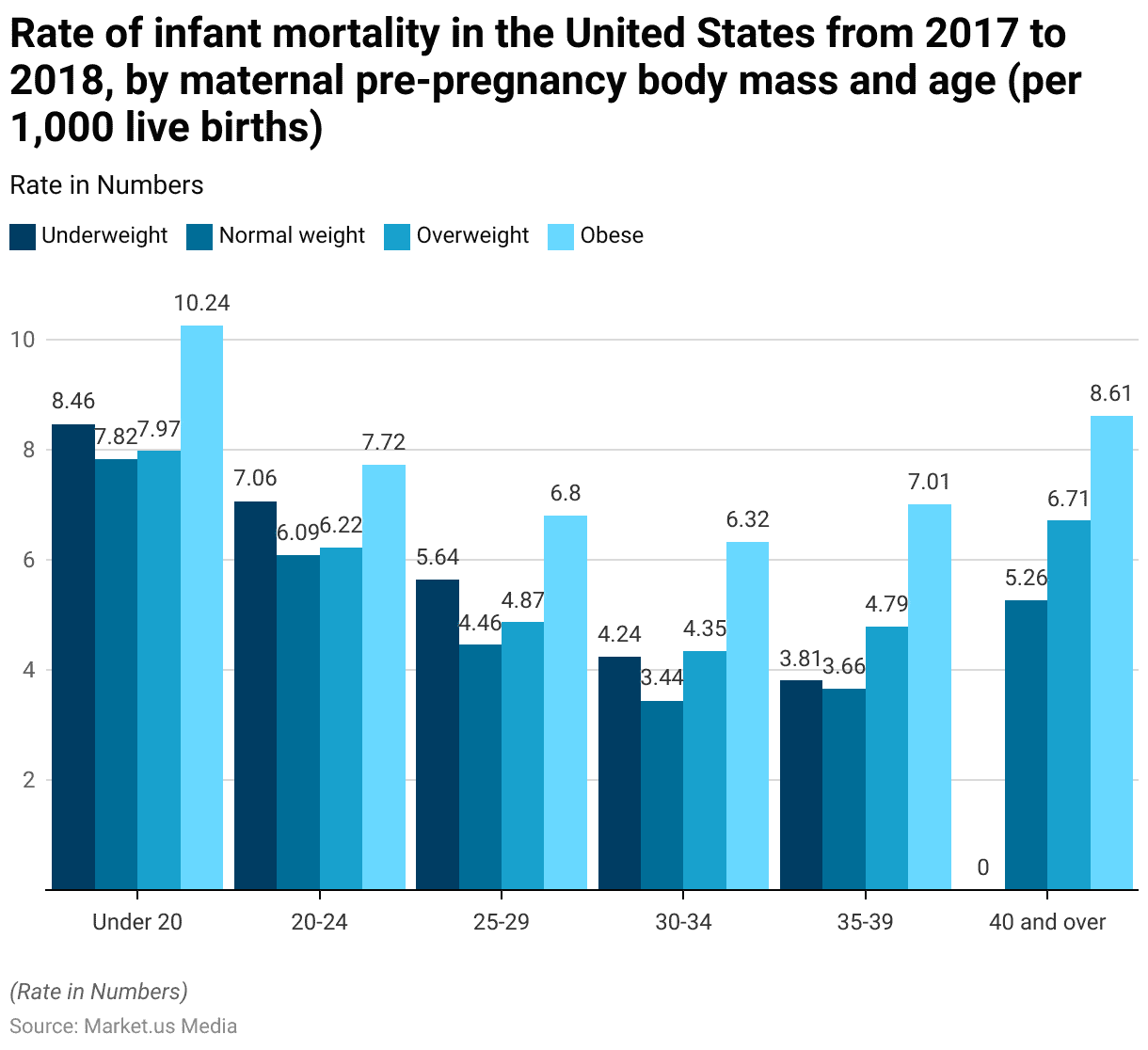
Causes of Infant Death Detected Through Clinical Perinatal Software
- In 2022, the leading causes of infant death in the United States were diverse, with congenital malformations accounting for 19.30% of all infant deaths.
- Low birth weight was the second leading cause, responsible for 14% of infant deaths.
- Sudden infant death syndrome (SIDS) followed, constituting 7.40%, and unintentional injuries accounted for 6.60%.
- Maternal complications contributed to 5.90% of infant deaths, while cord and placental complications were responsible for 3.20%.
- Bacterial sepsis of the newborn caused 3.10% of deaths, and respiratory distress of the newborn was the cause in 2.20% of cases.
- Intrauterine hypoxia and birth asphyxia accounted for 1.80% of infant deaths, and diseases of the circulatory system were responsible for 1.70%.
- This distribution underscores the multifaceted nature of infant mortality in the United States.
(Source: Statista)
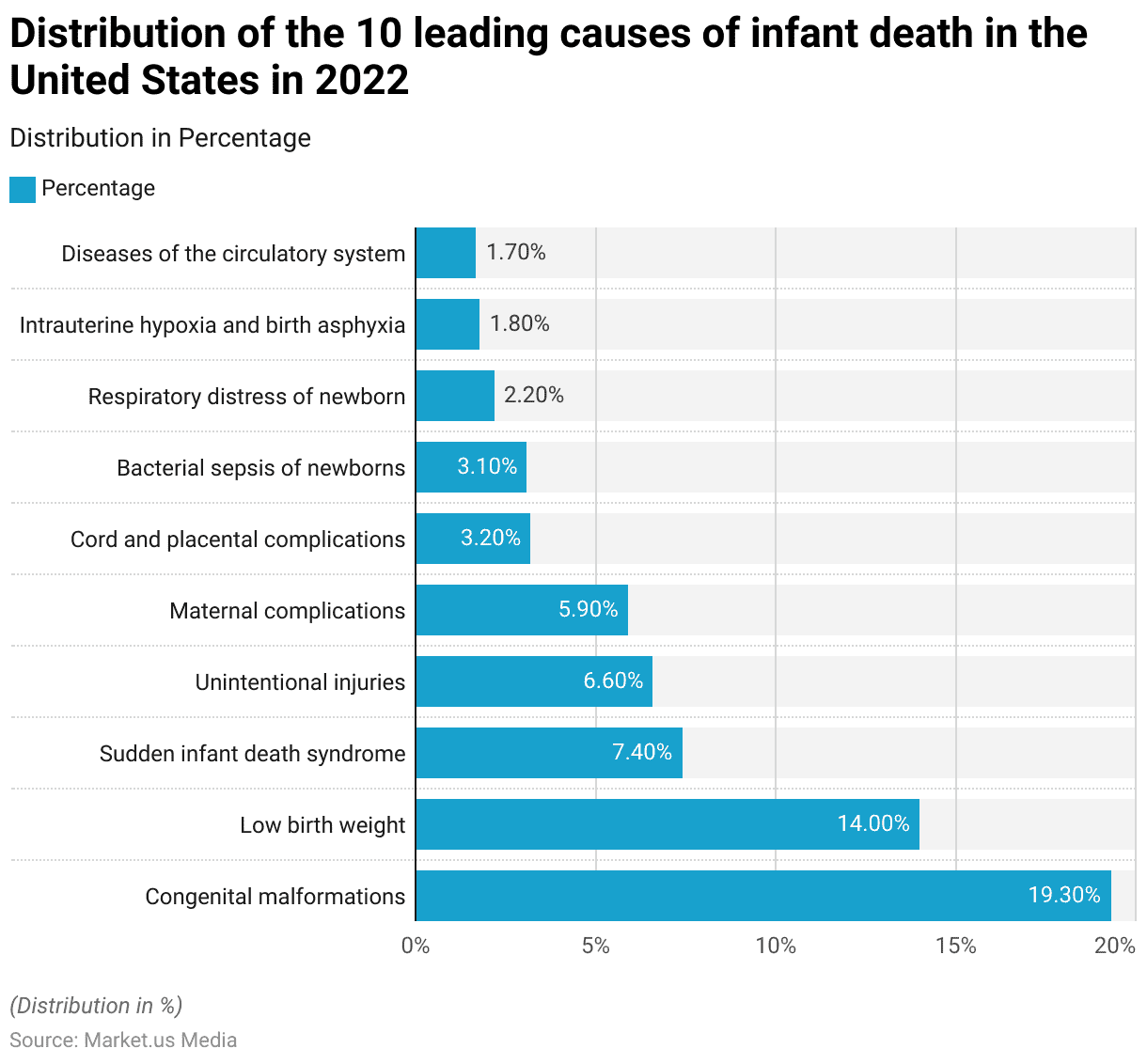
Key Components in Clinical Perinatal Software Statistics
- Key components in clinical perinatal software are designed to enhance maternal and fetal care through comprehensive data integration, real-time monitoring, and advanced analytics.
- These components include maternal-fetal surveillance systems that provide early warning alerts for potential complications, significantly improving patient safety by reducing incidents like uterine tachysystole and unexpected NICU admissions.
- For example, PeriGen’s PeriWatch platform integrates statistical analysis features to offer consistent, real-time data analysis, allowing clinicians to focus more on direct patient care rather than manual data management.
- Additionally, Philips’ IntelliSpace Perinatal system offers a modular design for flexibility and scalability, supporting everything from non-stress tests to full departmental surveillance and charting solutions, ensuring vital signs and alerts are seamlessly integrated and accessible across various platforms.
- This robust integration and real-time data processing are crucial for enhancing clinical efficiency and standardizing care during childbirth.
(Source: PeriGen, Philips)
Key Indicators in Clinical Perinatal Software
Major Indicators
- Key indicators in clinical perinatal software are crucial for monitoring and improving maternal and fetal health outcomes.
- The stillbirth rate is calculated by dividing the number of stillbirths by the total number of births (both stillbirths and live births) and is expressed per 1,000 births.
- The percentage of stillbirths that are antepartum is determined by dividing the number of antepartum stillbirths by the total number of stillbirths multiplied by 100.
- The early neonatal mortality rate measures early neonatal deaths (occurring between 1 and 7 days) per 1,000 live births.
- The perinatal mortality rate combines the number of stillbirths and early neonatal deaths divided by the total number of births expressed per 1,000 births.
- Lastly, the neonatal mortality rate accounts for neonatal deaths (occurring between 1 and 28 days) per 1,000 live births.
- These indicators provide essential data for assessing and addressing perinatal health challenges.
(Source: Healthy Newborn Network)
Other Indicators
- Additional key indicators in clinical perinatal software provide a comprehensive view of maternal and neonatal health.
- The maternal mortality ratio is calculated by dividing the number of maternal deaths by the number of live births, expressed per 100,000 live births.
- The cesarean section rate measures the number of cesarean deliveries as a percentage of total births, including stillbirths and live births.
- The assisted deliveries rate, also expressed as a percentage, indicates the number of deliveries that required medical assistance out of the total births.
- The low birth weight rate quantifies the number of babies born weighing less than 2500 grams per 1,000 live births.
- Lastly, the preterm rate measures the number of babies born before 37 weeks of gestation per 100 live births.
- These indicators are essential for evaluating and improving perinatal care and outcomes.
(Source: Healthy Newborn Network)
Investments in Clinical Perinatal Software
- Governments are increasingly funding digital health solutions to enhance maternal and neonatal care, focusing on reducing mortality rates and improving healthcare outcomes.
- For instance, the integration of advanced technologies like artificial intelligence and data analytics into perinatal software is a priority, supported by substantial government grants and initiatives.
- Private sector investments are also robust, with major companies such as Philips Healthcare and PeriGen Inc. leading the charge. These firms are investing heavily in research and development to introduce innovative products and expand their market presence through strategic partnerships and acquisitions.
- This combined investment effort from both the public and private sectors is crucial for advancing clinical perinatal software, ultimately aiming to provide better care for mothers and infants globally.
(Source: National Library of Medicine)
Regulations for Clinical Perinatal Software
- Regulations for clinical perinatal software vary by country and are designed to ensure the safety, efficacy, and security of these digital health solutions.
- In the United States, the Centers for Medicare & Medicaid Services (CMS) has implemented electronic clinical quality measures (eCQMs) such as ePC-02 and ePC-07, which focus on cesarean birth rates and severe obstetric complications, respectively.
- These measures aim to improve patient outcomes and ensure consistent data collection across healthcare providers. Compliance with Health Insurance Portability and Accountability Act (HIPAA) regulations is also mandatory, ensuring the protection of patient data.
- In Europe, clinical perinatal software must comply with the General Data Protection Regulation (GDPR), which mandates strict data privacy and security measures.
- Additionally, the Medical Device Regulation (MDR) outlines the requirements for software that functions as a medical device, including clinical evaluations and post-market surveillance.
- Globally, countries like Australia and Canada follow similar frameworks, adapting international standards to their healthcare systems to ensure the interoperability and security of perinatal software solutions.
- These regulations collectively aim to enhance the quality of maternal and neonatal care while safeguarding sensitive health information.
(Source: Medisolv, Official Journal of the European Union)
Recent Developments
Acquisitions:
- Cerner Corporation’s Acquisition of Kantar Health: On April 1, 2021, Cerner Corporation acquired Kantar Health, a healthcare data analytics and research company. This acquisition aims to expand Cerner’s capabilities in healthcare data analytics and informatics, including perinatal care.
New Product Launches:
- Philips Healthcare’s Avalon CL Fetal and Maternal Pod: On June 12, 2020, Philips Healthcare launched the Avalon CL Fetal and Maternal Pod. This wearable fetal monitoring device provides continuous monitoring of fetal and maternal vital signs and is designed to be comfortable for pregnant women, allowing mobility during labor and delivery.
Funding:
- PeriGen’s Advanced Perinatal Software: PeriGen has been focusing on enhancing its PeriWatch® platform, which incorporates advanced statistical analysis features to improve clinical efficiency and standardization of care during childbirth. The platform provides real-time data analysis, allowing clinicians to focus more on direct patient care.
Market Growth:
- Global Market Expansion: The growth is driven by the increasing adoption of clinical perinatal software solutions in healthcare organizations and rising awareness of their benefits in reducing maternal and neonatal mortality rates.
- Regional Insights: North America holds the largest market share due to its advanced healthcare infrastructure and high disposable income. The Asia-Pacific region is expected to experience significant growth, driven by government initiatives to support healthcare IT adoption and the rising adoption of healthcare facilities in countries like China and India.
Innovation and Trends:
- Integration with AI and IoT: Companies are integrating AI and IoT technologies into their clinical perinatal software to enhance monitoring capabilities and data analysis. This integration allows for better patient outcomes and more efficient healthcare delivery.
- Focus on Patient Safety: PeriGen’s PeriWatch® platform, for example, is designed to enhance patient safety by providing early warning systems and real-time data analysis to detect potential complications during labor and delivery.
Conclusion
Clinical Perinatal Software Statistics – In summary, the clinical perinatal software market is experiencing robust growth due to rising demand for advanced solutions in maternal and neonatal healthcare.
Factors such as increased healthcare spending and government initiatives contribute to this growth. Cloud-based solutions are particularly popular for their scalability and accessibility, empowering healthcare providers to deliver personalized care.
Challenges include interoperability issues and data security concerns, while competition drives strategic partnerships and mergers.
Despite these challenges, the market is expected to expand further, driven by technological advancements and evolving care delivery models. Adaptability will be key for market players to sustain growth in this dynamic landscape.
FAQs
Clinical perinatal software is a digital solution designed to enhance maternal and fetal care by integrating data from various sources, providing real-time monitoring, and supporting clinical decision-making. It helps healthcare providers monitor the health of pregnant women and their babies during the perinatal period, which includes the time before, during, and after childbirth.
Key components typically include fetal monitoring data services, workflow management tools, patient documentation systems, and maternal-fetal surveillance systems. These components work together to provide comprehensive care by tracking vital signs, managing clinical workflows, and ensuring data integration across different healthcare systems.
Clinical perinatal software improves patient care by offering real-time data analysis and alerts for potential complications, thus enabling timely interventions. It also streamlines administrative tasks, reduces manual data entry, and enhances communication among healthcare providers. This leads to more accurate and efficient care for both mothers and babies.
Regulations for clinical perinatal software vary by region. In the United States, it must comply with Health Insurance Portability and Accountability Act (HIPAA) regulations and CMS’s eCQMs, such as ePC-02 and ePC-07. In Europe, the software must adhere to the General Data Protection Regulation (GDPR) and the Medical Device Regulation (MDR). These regulations ensure data privacy, security, and the safe use of medical software.
Challenges include interoperability issues, resistance to change within healthcare practices, the need for extensive training, and the high cost of implementation. Ensuring seamless data exchange among different systems and gaining acceptance from healthcare providers is critical for successful implementation.
Discuss your needs with our analyst
Please share your requirements with more details so our analyst can check if they can solve your problem(s)



